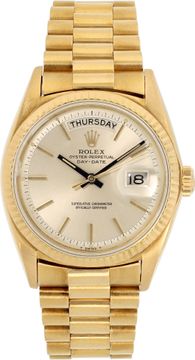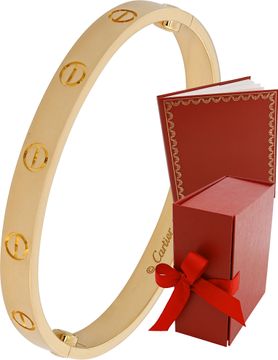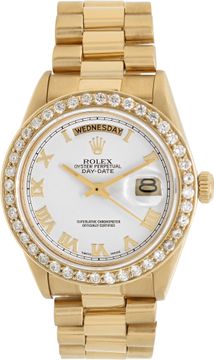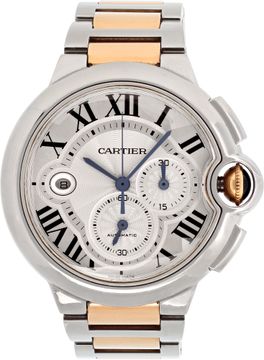Evolution of the Rolex Daytona
The Rolex Cosmograph Daytona, one of the most sought-after luxury watches on the planet, turns 60 years old this year. How has this iconic chronograph evolved over the years? Surprisingly, unlike so many other Rolex models, the Daytona of today is quite different from how it started in terms of aesthetics and mechanics. Another significant change is the fact that the Cosmograph Daytona was once one of Rolex’s slowest-selling models, which is quite astounding given its immense popularity today. So in honor of this famed chronograph’s 60th birthday, let’s take a deep dive into the history and evolution of the Rolex Daytona.
Rolex Daytona Origins: The Early Years
- 1963 to 1988
- Four-digit reference numbers
- 38.5mm cases; mainly stainless steel but some yellow gold options too
- Tachymeter bezels (metal or acrylic)
- Manual-winding movements
Rolex introduced the Cosmograph as its flagship racing chronograph watch in 1963. At first, “Daytona” was not part of the watch’s name; Rolex actually initially called it the Cosmograph “Le Mans” after the famed French endurance race. However, Rolex quickly switched the name to Cosmograph Daytona (named after Floriday’s famous racing city) as the company was aggressively going after the American market.
The first Rolex Daytona watch was reference 6239. It featured a compact 37.5mm case, a metal bezel engraved with a tachymeter scale, a pair of pump-style pushers flanking the winding crown, three counters on the dial, and an Oyster bracelet. What’s more, inside the case was a manual-winding Valjoux based movement. That’s right, vintage Rolex Daytona models with four-digit reference numbers are manual-winding chronographs.
A couple of years later, Rolex launched the Daytona reference 6241, which was almost identical to the Datyona 6239 except for the black acrylic bezel instead of a metal one.
During the time the Daytona ref. 6239 and 6241 were in production Rolex also manufactured the Daytona 6240; however, this reference was considered a prototype more than a regular production watch. Rolex was experimenting with increased water resistance by introducing screw-down chronograph pushers to the Daytona 6240 (and subsequently added the “Oyster” label to the dial)–if you follow Rolex at all, you understand the importance of waterproof cases. So this particular evolution of the Rolex Daytona makes complete sense in the context of the brand’s history.
Despite making a Daytona Oyster reference with pump pushers, the next two references would revert back to the pump style pushers and non-Oyster cases: the Daytona 6262 (metal bezel) and 6264 (acrylic bezel). The biggest change of these Daytona watches was an updated higher-beat manual-winding Valjoux movement.
Finally, in 1971, Rolex launched what would become the two longest-running manual-winding Daytona references, the 6265 (metal bezel) and 6263 (acrylic bezel). These two now-vintage Rolex Daytona watches brought together the best of all preceding references and a few new updates. They featured screw-down chronograph pushers, an Oyster case with a Triplock winding crown, and a high-beat manual-winding movement.
Paul Newman Dials
While vintage Rolex Daytona watches are already highly collectible, the ones with the so-called Paul Newman dials are even more desirable. Paul Newman dials, which Rolex officially calls “exotic dials,” are named after the famous actor who wore one. They are characterized by the following design traits:
- Art Deco-style fonts on the three counters
- Hash marks with square tips on the counters
- 15/30/45/60 numerals on the 9 o’clock subdial (standard dials have 20/40/60 numerals)
- A different colored stepped-minute track around the periphery of the dial
- Shorter square and rectangular indexes at the hours (standard dials have long batons hour markers)
A vintage Rolex Daytona with a Paul Newman dial is exceedingly collectible and some of the most expensive watches in the collector’s market. In 2017, Paul Newman’s own Daytona “Paul Newman” sold for a record-breaking $17.8 million at auction.
Vintage Rolex Daytona Specs
Reference Production Years
(Approx.) Case Material
Bezel Type Movement Special Notes 6239 1963 to 1969 Steel or Yellow Gold
Metal Caliber 722 First Daytona Watch 6241 1966 to 1969 Steel or Yellow Gold
Acrylic Caliber 722 6240 1965 to 1969 Steel Only
Metal Caliber 722 Screw-Down Pushers
Oyster Case 6262 1970 Steel or Yellow Gold
Metal Caliber 727 6264 1970 Steel or Yellow Gold
Acrylic Caliber 727 6265 1971 to 1988 Steel or Yellow Gold
Metal Caliber 727 Screw-Down Pushers
Oyster Case
Triplock Crown 6263 1971 to 1988 Steel or Yellow Gold
Acrylic Caliber 727 Screw-Down Pushers
Oyster Case
Triplock Crown
Rolex Daytona Evolves: The Zenith Years
- 1988 to 2000
- Five-digit reference numbers
- 40mm cases
- Stainless steel, two-tone steel/yellow gold, yellow gold, white gold
- Metal bezels engraved with tachymeter scales
- Metal Oyster bracelets or leather straps
- Caliber 4030 automatic movements based on the Zenith El-Primero
The evolution of the Rolex Daytona in 1988 was a dramatic one. Rolex essentially redesigned its chronograph collection from the inside out. Not only did the case size grow to 40mm but the movement inside the watch changed too. For these then-new Daytonas, Rolex opted for a modified caliber based on the famous Zenith El Primero automatic movement and named it Caliber 4030.
The first batch of these five-digit Daytona “Zenith” watches was offered in stainless steel (ref. 16520), yellow gold (ref. 16528), and–for the first time for the collection–two-tone steel and gold (ref. 16523). As the collection evolved, Rolex added new versions with leather straps instead of Oyster bracelets including a yellow gold version (ref. 16518) and a white gold version (ref. 16519).
Moreover, Rolex began rolling out some very special gem-set Daytona watches with precious stones in the bezels (such as diamonds, sapphires, emeralds, and rubies) instead of a tachymeter scale.
Rolex Daytona “Zenith” Specs
Reference Case Material
Bracelet/Strap Introduction
Year Daytona 16520 Stainless Steel
Oyster 1988 Daytona 16528 Yellow Gold
Oyster 1988 Daytona 16523 Stainless Steel/Yellow Gold
Oyster 1988 Daytona 16518 Yellow Gold
Leather 1992 Daytona 16519 White Gold
Leather 1997
Like almost all Daytona watches, the so-called Zenith versions are highly collectible. Not quite vintage but certainly neo-vintage, this generation marks a significant era of the evolution of the Rolex Daytona when the model transitioned from old-school manual-winding chronographs to modern automatic ones. One quick way to identify a Zenith Daytona is to look at the dial–if the running seconds indicator is at 9 o’clock, then it’s one with Caliber 4030 inside the case.
Rolex Daytona Goes In-House
- 2000 to present
- Six-digit reference numbers
- 40mm cases
- Stainless steel, two-tone steel/yellow gold, yellow gold, white gold, Everose gold, platinum
- Metal or Cerachrom ceramic bezels engraved with tachymeter scales
- Metal Oyster bracelets, leather straps, or rubber Oysterflex bracelets
- Caliber 4130 automatic movements made in-house
Another major moment in the evolution of the Rolex Daytona arrived in the year 2000 when the company switched to an in-house made movement called Caliber 4130. Unlike the previous Valjoux and Zenith-based calibers, Caliber 4130 is an automatic chronograph movement developed and manufactured entirely by Rolex.
The first models that launched this new six-digit Daytona generation were offered in steel (ref. 116520), yellow gold (ref. 116528 and ref. 116518), steel/gold (ref. 116523), and white gold (ref. 116519). Most of these references were paired with metal Daytona bracelets but a select few had leather straps. A particularly notable sub-collection is the Daytona “Beach” variants, which came out in the early-2000s, in white gold with colorful exotic dials and exotic leather straps.
Soon enough, the Daytona ref. 116505 crafted from Everose gold, which is Rolex’s proprietary rose gold alloy, joined the catalog. Then, in 2011, Rolex debuted a Daytona watch with a bezel made from Cerachrom, which is Rolex’s proprietary ceramic alloy. Depending on the case material, a Rolex Daytona is now available with either metal, ceramic, or gem-set bezels. A Daytona with a ceramic bezel will have the letters “LN” in its reference numbers.
To celebrate the 50th anniversary of the Daytona in 2013, Rolex introduced a platinum version (ref. 116506) — a first for the collection.
Another interesting update to note within the Daytona collection is the addition of the Oysterflex bracelet. Oysterflex is Rolex’s version of a black rubber strap, which includes a metal blade at the center (this is why it’s called a bracelet and not a strap). Rolex eventually replaced all of its leather straps variants with Daytona watches with Oysterflex bracelets.
In-House Rolex Daytona Specs
Reference Case Material
Bezel Material Bracelet/Strap Year
Introduced 116520 Stainless Steel
Stainless Steel Oyster 2000 116528 Yellow Gold
Yellow Gold Oyster 2000 116523 Steel/Gold
Steel/Gold Oyster 2000 116518 Yellow Gold
Yellow Gold Leather 2000 116519 White Gold
White Gold Leather 2000 116509 White Gold
White Gold Oyster 2004 116505 Everose Gold
Everose Gold Oyster 2008 116515LN Everose Gold
Black Cerachrom Leather 2011 116506 Platinum
Brown Cerachrom Oyster 2013 116500LN Stainless Steel
Black Cerachrom Oyster 2016 116503 Steel/Gold
Steel/Gold Oyster 2016 116508 Yellow Gold
Yellow Gold Oyster 2016 116518LN Yellow Gold
Black Cerachrom Oysterflex 2017 116519LN White Gold
Black Cerachrom Oysterflex 2017 116515LN Everose Gold
Black Cerachrom Oysterflex 2017 116595RBOW Everose Gold
Rainbow-Colored Sapphires Oyster 2018
The stainless steel Daytona ref. 116500LN with a black Cerachrom bezel is one of the most desirable modern chronographs in the market today, often selling for more than double the retail price. Other notably collectible models within the current lineup include the yellow gold Daytona 116508 “John Mayer” with a green dial and the Daytona 116595 “Rainbow” with a multi-colored sapphire-set bezel . However, it must be said that all modern Daytona watches by Rolex are popular. In 2021, Rolex rolled out some stunning meteorite dials on select gold Daytona watches.
An easy way to recognize a Daytona with an in-house Caliber 4130 is to look at the dial–the running seconds counter should be at the 6 o’clock position.
The Appeal of the Rolex Daytona
The evolution of the Rolex Daytona has witnessed more than a few major makeovers over the last six decades. Once a flop for the company, today it’s one of the fastest selling Rolex watches. From changes in movements and case sizes to more material options and bracelet styles, this famed chronograph watch continues on its winning streak.
Whether vintage, retro, or modern, it’s hard to deny the appeal of the Rolex Daytona. Sporty yet luxurious, generously sized on the wrist yet sllim and comfortable, it comes as no surprise that the Daytona is not only Rolex’s most desirable watch but also the industry at large.
It’ll be interesting to see what Rolex has in store for the 60th anniversary of the Daytona this year, and we’ll be on the lookout for any significant announcements.
How to find the perfect size band or strap for your Luxury Watch.
NEXT ARTICLE
Audemars Piguet Royal Oak Perpetual Calendar
















